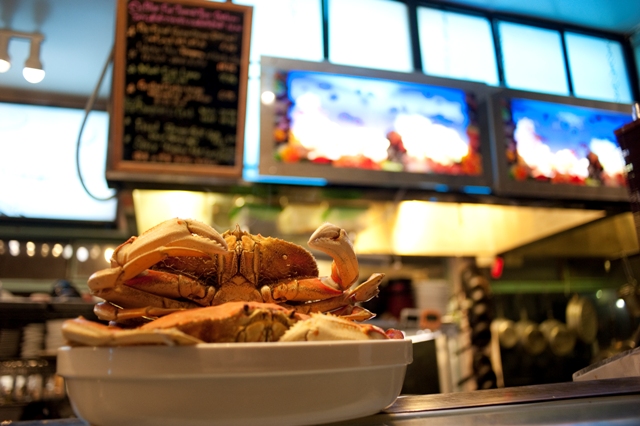Oriental Breeze, the most authentic Japanese restaurant almost nobody in the South Bay knows about

Near the end of the Redondo Pier is a stand that sells funnel cakes, hot dogs, French fries, nachos, and ice cream, among other fast food. It has been open for many years and is reminiscent of places I’ve seen at New Jersey boardwalks, North Carolina ferry terminals, and other tourist attractions. The place probably has a name, but I don’t know what it is – the signs and the writing on the awning just list the specialties, such as they are.
I’m not going to write about the food at this garish eatery, but at the place next door that is in the shadow of the glaring lights and the big plastic ice cream cone. Oriental Breeze doesn’t look like much from the outside, an unpromising architectural hodgepodge dominated by a pink and blue neon “SUSHI” sign. The name, exterior, and neighborhood certainly don’t suggest that inside is an unusually authentic Japanese restaurant, but in fact that’s exactly what it is.
[scrollGallery id=292] The restaurant is small, with a sushi bar right by the entrance and a few tables that share a view of the ocean. We took a few minutes examining the specials board and the very large menu, noticing some items on each that are only offered in places with a Japanese clientele. We resisted the urge to order motsu, the spicy tripe stew, but decided to start with vinegared pike and squid liver along with more conventional albacore and onion salad, uni and Spanish mackerel sushi, and spicy tuna roll.The pike arrived prettily arranged with shaved cucumber, sprouts, and green onion over a bed of pickled white onions and fish, with specks of thinly sliced red chili peppers adding a dash of color and mild spicy bite. The cold pike filets were slightly chewy rather than flaky, reminiscent of Scandinavian and German pickled fish dishes. Most Americans seek flaky, very lightly flavored fish and don’t know what they’re missing; if you like the richer flavor you will find this a treat.
Next to arrive was the ahi salad, thick slices of lightly seared fish topped with green onions in a very gingery dressing with healthy amounts of roasted garlic. It’s not a strictly traditional Japanese dish, as Japanese usually like their fish either cooked or raw but not seared, but it was very tasty and the portion was generous. I would order either this or the pike next time, but not both, as we had accidentally selected two dishes with a very strong onion flavor to begin our meal. The remedy to those strong flavors arrived next, Spanish mackerel sushi and the best uni (sea urchin) I’ve had in years. Uni spoils very quickly and is nasty when it does, but when fresh it’s like eating a sea breeze. This hit the spot, and the meaty, rich Spanish mackerel was a fine companion to it. It was a fine way to reset our palates for the challenging dish that arrived next.
Though Japanese food has a reputation for mild and delicate flavors, there are dishes in the regional cuisines that push the limit for salty, fishy flavors. One of these is salted squid liver a dish sometimes listed on menus as salted guts. The texture is distinctly that of liver, dense and moist, it is salty and fishy, and it’s an acquired taste. I had sampled it years ago and found it odd but interesting. This time I was dining with my daughter, who had never tried it before, and I was interested to see her reaction. We agreed that the flavor was interesting but the salt overpowered everything else; it was served with cream cheese and crackers, and alternating bites with the liver helped, as did a squeeze of lemon or a bite of the chopped daikon that was provided on the side of the plate. It’s not a dish either of us must have again, but we were glad we gave it a chance.
We finished with a more conventional dish that we knew we both liked, char-grilled sea bass that had been marinated in sweet miso sauce. It had been done perfectly; the edges crusted black with caramelized sugars, the interior so moist that it was almost liquid. It was pure fish bliss, served over crunchy fried rice noodles that added no flavor but were fun to crunch at, and we enjoyed it completely. Our server told us that this and many other items on the menu are specialties of the Kansai region, an area south of Tokyo that claims the invention of both miso and soy sauce, and they certainly use it well in this dish.
We had accompanied our meal with tea and sake, despite the temptation of several types of shochu and mixed drinks. The sake and shochu lists are not as comprehensive as in some other establishments around town, but the overall quality is high and prices are quite reasonable.
I had visited Oriental Breeze when it was located on the International Boardwalk north of the pier, and I had been impressed then – it was the most authentic Japanese restaurant that almost nobody in the South Bay knows about. Five years later it still has a claim to that title, because most locals would never think of going to the Redondo Pier in search of authentic experiences. In this case they are missing a gem that is in plain sight, right next to the hot dog stand.
Oriental Breeze is at 207 Fisherman’s Wharf in Redondo Beach, just west of Old Tony’s. Parking in pier lots (not validated). Phone 310-683-8316.










